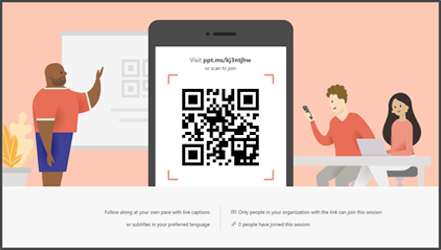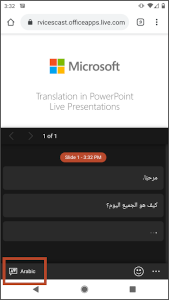
Lectures & Presentations
Create an inclusive classroom experience with Microsoft PowerPoint
Microsoft PowerPoint provides live captioning and translated subtitling of a teacher’s lectures in many languages including English. These subtitles enable deaf or hard of hearing students and language learners to follow along with lectures and presentations.
- System Requirements
- Windows: Requires Windows 10, and PowerPoint for Microsoft 365 version 16.0.11601.20178 or higher
- Mac: PowerPoint for Microsoft 365 for Mac version 16.22.127.0 or higher
- Web (Note: multilingual subtitling is only available on the web): Compatible with the following web browsers: Microsoft Edge, Google Chrome 34+, Mozilla Firefox 25+
- WiFi or cabled Internet connection. A cable connection is preferred to minimize latency.
- Wear a microphone. PowerPoint subtitling works best when you wear a mic that sits close to your mouth. See the list of recommended headsets
1. In the Slide Show ribbon tab, select Subtitle Settings

2. Use Spoken Language to see the voice languages that PowerPoint can recognize and select the one you want. This is the language that you will be speaking while presenting.
3. Use Subtitle Language to see which languages PowerPoint can display on-screen as captions or subtitles and select the one you want. This is the language of the text that will be shown to your audience. Choosing the same language as your Spoken Language allows you to provide closed captioning.
You can turn subtitles on and off by using the subtitle toggle in the Slide Show View or Presenter View.

Learn more about adding subtitles and captioning in the Microsoft Office website.
If your presentation requires subtitles in multiple languages at once, PowerPoint’s Live Presentation feature is native within PowerPoint for the web. With Live Presentations, students can see a presentation on their own devices and read live subtitles in their preferred language while you speak.
Live Presentations is currently only available for PowerPoint for the web. To use the feature, you will first need to save your presentation to the web.
1. In the Slide Show ribbon tab, select Presentation Live.

2. A QR code will appear on the screen. Have your students scan the code and the presentation deck will load in their devices’ web browser.

3. As you speak, subtitles will be displayed on the students’ screen below the deck. They can select the language of their choice in the language selection option.

Learn more about PowerPoint’s Live Presentation feature in the video below.
- Hold the microphone close to your mouth. Try to avoid or eliminate background noise that may interfere with your voice.
- Focus on proper articulation (no mumbling) and pause between sentences so the system can catch up (it waits for a pause to finalize the translation). If you follow these two principles, there is no need to speak slowly. If you see problems in the captions or subtitles, try speaking more deliberately.
- Avoid very short or very long sentences. The system (both for speech recognition and translation) uses the context of a full sentence. By providing more context, you will increase the chances for both to work better. Ideally, sentences between 5 and 15 words are perfect.
- If you’re bilingual, don’t switch languages. PowerPoint will only understand the language you chose.
Captions and subtitles depends on a cloud-based speech service, so it’s important to have an internet connection that’s fast and reliable.
You can host a multilingual Q and A following your presentation using Microsoft Translator’s multi-device conversation feature. Learn more here.




